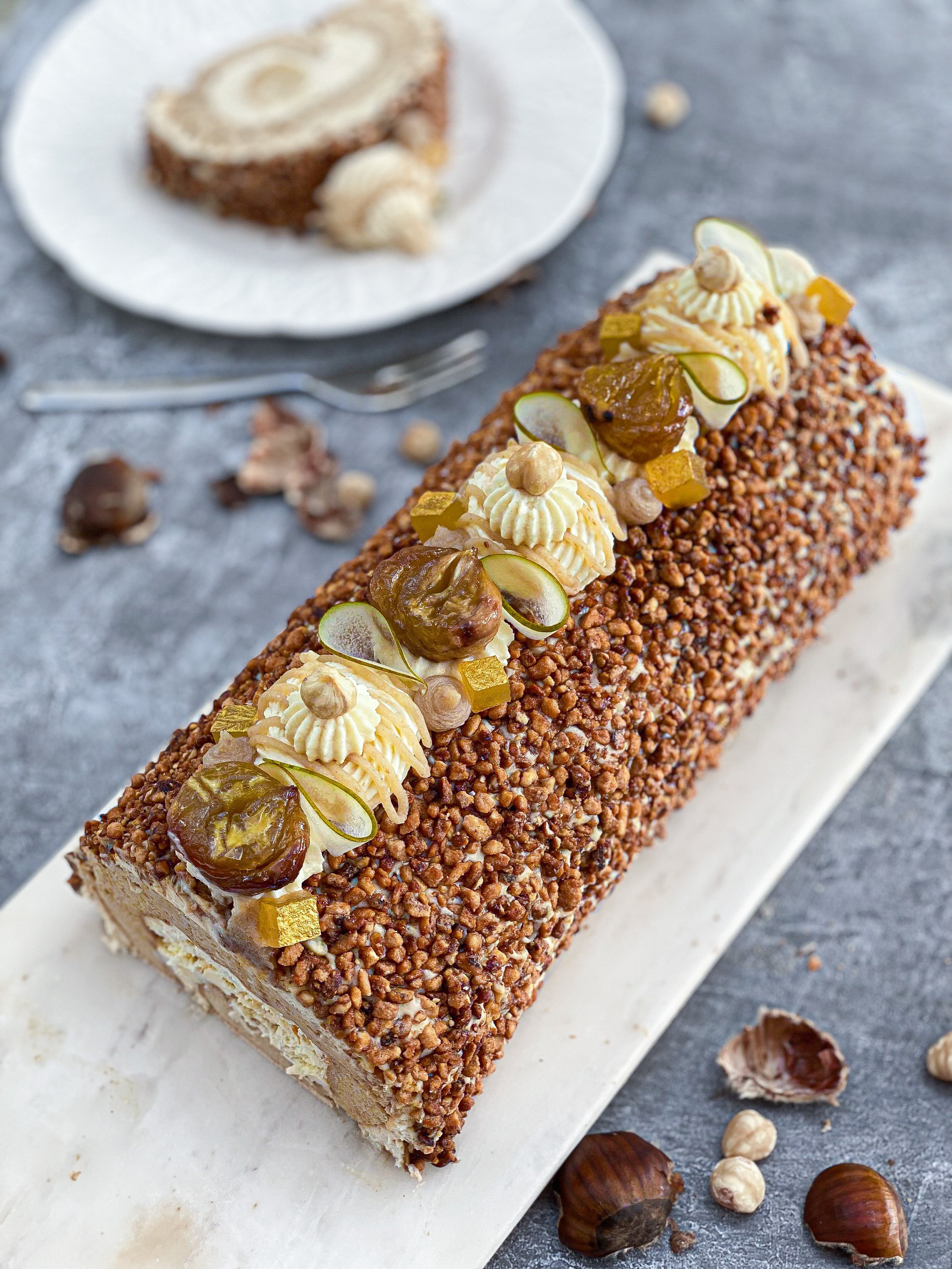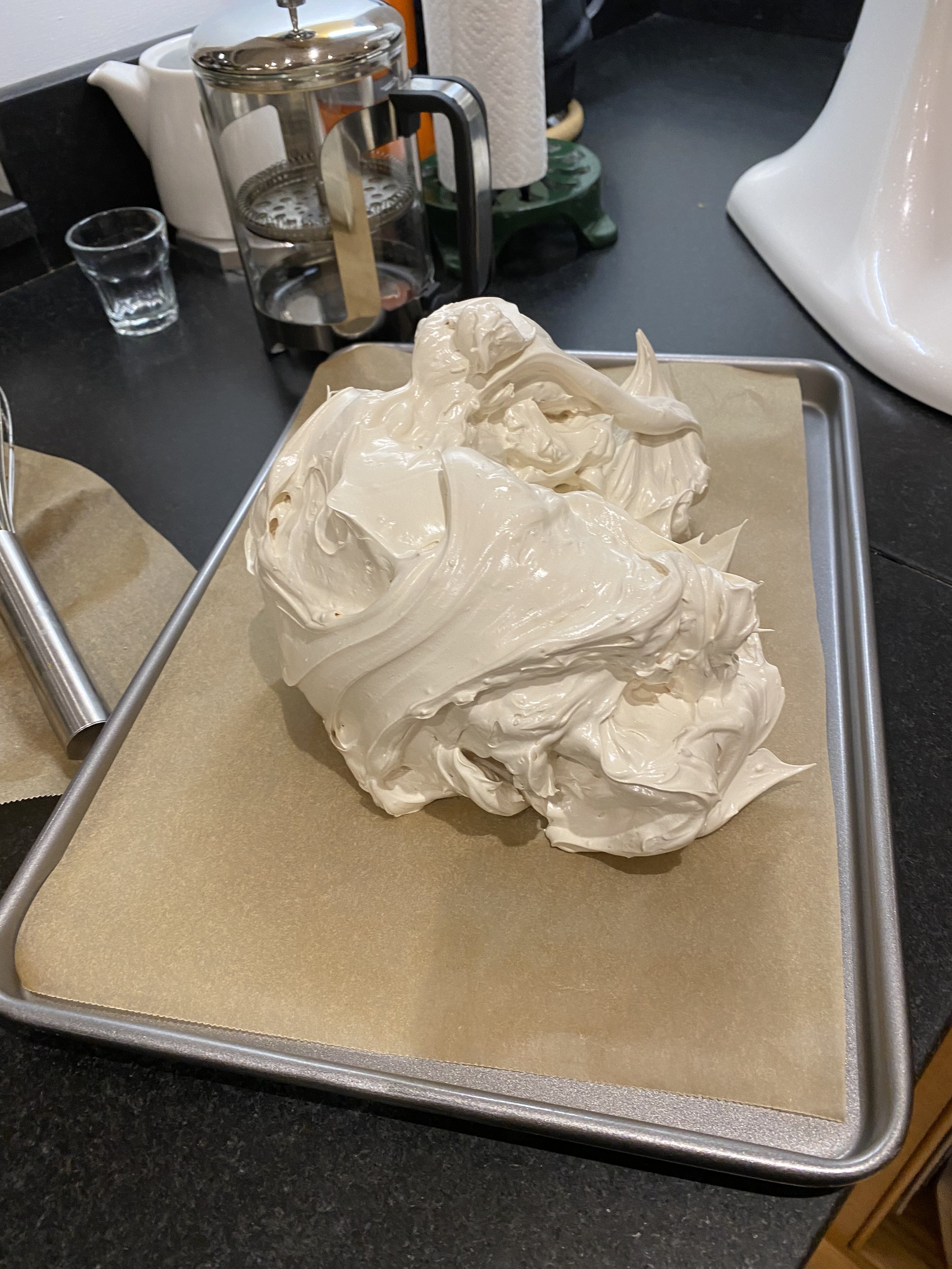Brown sugar meringue roulade with pear, hazelnut, chestnut and cognac

Poaching liquid for pears
Poached pear
pear and cognac jelly made from the poaching liquid for the pears
brown sugar meringue. It is a stone colour (white handle for comparison). When cooked it becomes a darker brown.
scored chestnuts about to be baked
vanilla and cognac whipped cream.
Chestnut cream (left) and hazelnut praline (right)
baked chestnuts without their shells
I went to Eataly in London for the first time the other week (which is crazy considering how utterly obsessed I have been with the culture and above all the cuisine of Italy since living there!) and I bagged myself a few baddies. I got some damson and cherry jams which I used to make jammy dodger style biscuits as festive gifts for my family, and I also picked up the chestnut cream pictured above. When thinking of what to do with the chestnut cream my mind went to mont blanc. The difficulty I faced however, was that I already had a meringue based dessert in the works! The dessert I had planned to develop was a hazelnut brown sugar meringue roulade based on a childhood food memory of a frozen supermarket pecan and caramel roulade that was my absolute favourite. I wanted to take the eating experience of that dessert and revamp the flavours a bit with hazelnut (my ride or die nut as you may have noticed from its ubiquity in my recipes) and elevate it with notes of pear and cognac. So I had a conundrum, as there is only so much meringue a human can safely eat (and, you will be relieved to know, my testing process is rather rigorous and involves me consuming many portions of dessert for strict scientific analysis). I decided to take a gamble and work the chestnut cream into my hazelnut brown sugar meringue plans. And it worked. Amazingly well. So well in fact that this is going to be the dessert I make for my family on Christmas day (and no doubt at any opportunity thereafter). Although I was inspired by this festive little jar of chestnut joy, I actually chose to make my own for the recipe so I could control the sweetness (as meringue is blindingly sweet as it is) and also so I could take the opportunity to learn about an ingredient I hadn’t really explored before; chestnuts!
I had never cooked with chestnuts before now and really enjoyed exploring their properties and flavour, experimenting with a few different varieties of chestnuts and a couple of preparations of them (including the candied ones I have decorated the top with). I have listed the ingredients for the chestnut puree and the candied chestnuts (marron glace) however I strongly recommend you buy them so you can spend more of the festive period with your loved ones rather than labouring over minor elements of this this sugary extravaganza.
Although I could talk about why this is my new favourite dessert for a few pages (even surpassing my childhood memory version!) I will instead save my words for explaining to you exactly how I made it, so that you can make it for your loved ones too. So buckle up, story time is over and we are about to get technical.
Brown meringue roulade with hazelnut, chestnut, pear and cognac
Ingredients:
Poached pears:
2 conference pears
Juice of 2 oranges
Juice of 2 limes
6 tablespoons cognac
2 teaspoons honey
A star anise
Teaspoon vanilla paste
Water to cover
Teaspoon agar agar
Brown Meringue:
5 egg whites
280g demerara sugar
Pinch of salt
Vanilla and Cognac Chantilly:
300ml double cream
Tablespoon icing sugar
Cognac to taste (a few capfuls)
Teaspoon vanilla paste
Chestnut purée and glace chestnuts*:
one large bag of Chestnuts
Simple syrup ( 100ml water, 100g caster sugar)
Additional Water
*I recommend you buy these
Hazelnut praline*:
150g skinless roasted hazelnuts
100g sugar
*This can be bought
Decoration:
Hazelnut and chestnut cream:
300 mls double cream
praline paste and chestnut cream to taste
Hazelnut niblets (bresilienne):
150g skinned chopped hazelnuts
75g sugar
10g water
Method:
1) Poach the pears: place the juice of 2 oranges, juice of 2 limes, 6 tablespoons cognac, 2 teaspoons honey, one star anise and 1 teaspoon vanilla paste is a small saucepan. Using a melon baller, ball two pears and place them in the liquid. If the pears are too hard to ball you can cube them, or slice them in half and then ball them after they have been poaching for a while (but not fully cooked). If the liquid does not cover the pears top up with a little water. Turn on the heat and bring to a gentle simmer and let the pears cook until tender. When the pears are cooked remove them from the liqueur. Save the liquor and reduce it on a high heat to remove any water you added. Add a teaspoon of agar agar and bring to a simmer and then immediately remove from the heat and pour into a Tupperware or any rectangular or square mould you like. At 40 degrees the agar will set so there is no need to refrigerate. If the mix does not set (acidity levels vary and effect agar setting power), pour it back into the pan, add another teaspoon of agar and bring to a simmer again. Pour into moulds again and wait for it to set. When set, demould and slice into cubes for decorating the cake with.
2) Make the hazelnut praline: toast hazelnuts in the oven at 180 until lightly golden and fragrant. Make a dry caramel (add the sugar directly into a heavy based pan and heat until a golden brown caramel is achieved that is the colour of golden syrup). Pour the caramel onto a piece of parchment and allow it to cool. When cool, break the caramel into pieces and blend in a high powered blender with the hazelnuts until a smooth, liquid paste is achieved. Store in an airtight container.
3) Make the Hazelnut niblets (bresillienne): Toast chopped hazelnut pieces in the oven at 180C until golden and fragrant. Place the water and sugar in a saucepan and allow to simmer until the sugar is no longer visible and a crystal clear rapidly boiling syrup forms (5 minutes approximately). Add in the hazelnut pieces and stir continuously with a wooden implement or heat proof plastic. The caramel will start to form around the nuts but make sure you stir a lot and control the heat as they are easily burned (especially around the edges of the pan). When the nuts are coated in a light caramel, tip them onto parchment and spread them out as much as possible. Once they are cool you can rub the clusters together to break up the niblets.
4) Make the meringue and cream: preheat the oven to 200C/180C Fan. Line a 23x33cm swiss roll tin with non stick baking paper. Place water in the bottom of a pan and bring to the boil. Place the eggs and sugar in the bowl of a stand mixer (or a large bowl if you are using a hand mixer). Put the bowl over the pan of simmering water and whisk continuously with a balloon whisk. The bottom of the bowl should feel warm but not hot, as we don’t want to scramble the egg, rather just warm it slightly to dissolve the sugar. Rub the egg mix between your fingers and if you still feel sugar granules then keep whisking. If the mix feels smooth then remove from the pan and whisk on a stand mixer on high until a stiff meringue forms (10 minutes or so). Spread the meringue onto the swiss roll tin and smooth with a palette knife. Bake for 8 minutes and then lower the oven temperature to 160C/140C fan and cook for a further 15 minutes until firm to the touch. Lay some baking paper down on the counter top and turn the roulade out of the tin onto it. Peel off the baking paper from the side facing up (what was the base) and leave to cool for 10 minutes. During this time, make your whipped chantilly cream. Whip cream with sugar and vanilla until thickened but not stiff (very spreadable soft texture) then add the cognac to taste. If you over-whip the cream you can stir in some un-whipped cream to rectify this.
5) Construct the roulade. Spread the cream onto the meringue evenly. Pipe or spread some hazelnut praline and chestnut cream on top. Scatter and space the pear spheres over the top. Lightly score the meringue along one long side about 3cm from the edge. Use this as the starting point as you roll the meringue tightly using the paper to help you. This can now go in the fridge for up to 24 hours. The next stages (decoration) should be done just before serving.
6) Decorate the roulade: Whip the cream with some praline paste and some chestnut cream to taste. Spread it onto the roulade with a small palette knife and then smooth the surface with one sweeping motion using a strip of acetate (check my instagram @gggsarah for a video of this technique). Refrigerate until the cream has firmed up a bit. Press the hazelnuts niblets into the firmed up cream. Decorate the top with marron glace, the pear and cognac jelly, leftover cream, leftover chestnut puree and thinly sliced (I used a mandolin) slices of pear. You can see how to decorate the roulade on my instagram page.
Notes: The naked roulade (without the cream and niblet coating) will last 24 hours in the fridge. Once the cream is on the outside it will lose its crunch quite fast. Serve within 2 hours of decorating for best results. Store in the fridge.
Method for making the chestnut puree and candied chestnuts:
1) Score chestnuts with a cross (see picture above) and bake at 190C until they have burst open. Peel them and boil them in a saucepan of water until tender. Make a simple syrup (1 part water to 1 part sugar). Blend some of the chestnuts into a pulp then pass through a drum sieve (or fine mesh sieve). Put the pulp back in a blender and add teaspoons of cooled sugar syrup until you are happy with the sweetness and looseness of the puree (it should be a little sweet and thick enough to hold its shape when piped but not too thick to pass through the piping nozzle). For the glazed chestnuts, take the remaining whole chestnuts and boil in sugar syrup gently until translucent. Store them in the syrup in the fridge until needed.











